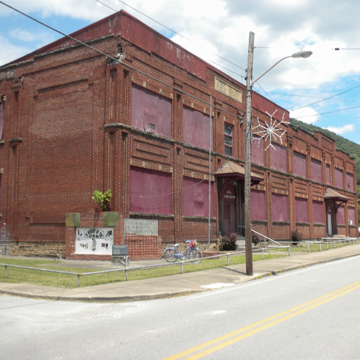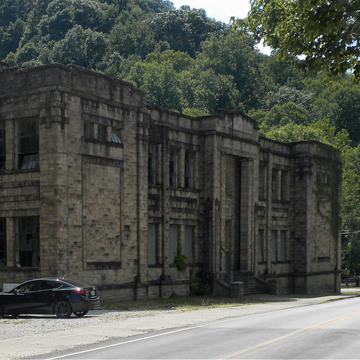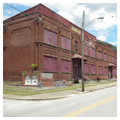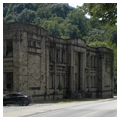You are here
Lynch Colored Public School
Lynch Colored School was built in 1923 by the U.S. Coal and Coke Company, a subsidiary of the U.S. Steel Corporation, to accommodate African American high school students then living in Lynch, a coal company town in the Appalachian Mountains. The Kentucky Day Law of 1904 mandated that African American children be schooled separately from whites but facilities were rarely equal. At the suggestion of Booker T. Washington, Sears, Roebuck and Company president Julius Rosenwald set up a fund to assist in the building of equitable schools for African Americans in segregated states. Building plans developed at the Tuskegee Institute were available free of charge to all, no matter the race or creed of the students for whom the buildings were intended. The Lynch Colored School bears a striking resemblance to those erected by the Julius Rosenwald Fund and is likely built from plans drawn up at the Tuskegee Institute. The survival of the building offers proof of the size and importance of the African American community in Lynch and of the far-reaching influence of the Rosenwald Fund.
In 1918–1919 the twelve African American students in Lynch were schooled by two teachers in a frame building set aside by the Camp Superintendent. Named after U.S. Coal and Coke president Thomas Lynch, the town was developed by U.S. Coal and Coke in 1920; all of its houses and public and commercial buildings were constructed and owned by the company. By 1923, Lynch had a population of 6,000—seventy-five percent of which was foreign born or African American. Among these were 567 African American children of high school age in 1923.
To accommodate these students, U.S. Coal and Coke built a large, two-story high school that was similar in size and form to Lynch’s white high school at the other end of town, its stark simplicity keeping with the company architecture. But whereas the public and commercial buildings in Lynch (including Lynch High School) were all constructed of limestone blocks, Lynch Colored School was faced entirely in brick. The two-story building is vaguely Beaux-Arts or commercial Italianate. The third bay from either end are given over to double-wide entry doors with cantilevered bracketed porch hoods, one to the school itself and one to the gymnasium. Large windows (now boarded over) occupy almost the entire width of each of the remaining eight bays. Large windows are a defining feature of Rosenwald schools, in case electrical light was not available. Articulated brick pilasters separate the bays and corners of the facade, with similarly raised brick relieving the fill between the floors. A thin limestone cornice line further separates the two stories and is visually linked to the one capping the short parapet of the primary facade. A higher parapet over the school entry is inscribed with the words “LYNCH COLORED/ PUBLIC SCHOOL,” while that leading to the gymnasium is blank.
The company leased the building to the Lynch Colored Common Graded School District, overseen by supervisor Lela Virginia Becker and superintendent B.B. Smith, both African American. Most of the school’s thirteen African American teachers graduated from Kentucky Normal School, now Kentucky State University. Lynch Colored School, also attended by students from nearby Benham, was the largest and reputedly the best of its kind in Eastern Kentucky.
African Americans represented a significant percentage of the workforce in Harlan County after World War I, and their children’s educational needs were addressed to a degree that was unusual in segregated Kentucky. Eighteen “colored” schools are known to have existed in Harlan County before 1963, the year U.S. Coal and Coke left Lynch. The town incorporated and some townspeople were able to purchase their houses from the company. Lynch Colored School closed its doors as a delayed response to enforced integration following the U.S. Supreme Court's 1954 decision, Brown v. Board of Education. The school gym has served as the meeting hall for the Eastern Kentucky Social Club since 1978 but like many buildings in this former company town, it is not regularly open to the public.
References
Hudson, Karen Elaine, “Lynch Historic District,” Harlan County, Kentucky. National Register of Historic Places Registration Form, 2002. National Park Service, U.S. Department of the Interior, Washington, D.C.
Leggs, Brent. Condition Assessment Report: Kentucky Rosenwald Schools. Prepared for Kentucky African American Heritage Council. Lexington: Kentucky Heritage Council, 1997.
Turley-Adams, Alicestyne. Rosenwald Schools in Kentucky 1917-1932. Prepared for Kentucky African American Heritage Council. Lexington: Kentucky Heritage Council, 1997.
Writing Credits
If SAH Archipedia has been useful to you, please consider supporting it.
SAH Archipedia tells the story of the United States through its buildings, landscapes, and cities. This freely available resource empowers the public with authoritative knowledge that deepens their understanding and appreciation of the built environment. But the Society of Architectural Historians, which created SAH Archipedia with University of Virginia Press, needs your support to maintain the high-caliber research, writing, photography, cartography, editing, design, and programming that make SAH Archipedia a trusted online resource available to all who value the history of place, heritage tourism, and learning.























